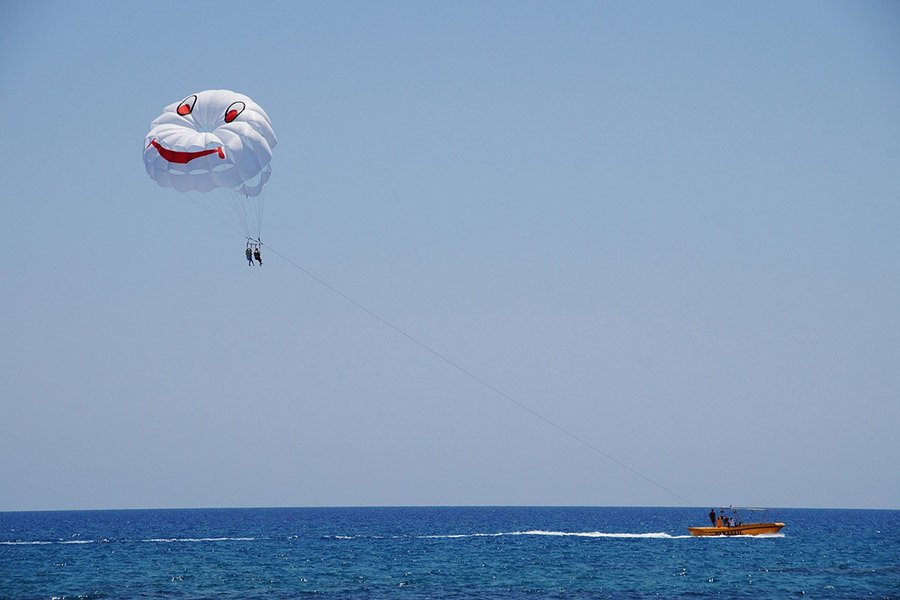Paragliding vs. Parasailing: How Do They Compare?
The dream of soaring above breathtaking landscapes has captivated adventurers for generations, and today, two popular activities make this dream a reality: paragliding and parasailing. While both involve flying through the air and taking in stunning views, they are vastly different in terms of how they work and the experience they provide.
Paragliding and parasailing are often confused because of their similar use of parachute-like equipment, but they cater to very different preferences and levels of involvement. Whether you’re seeking a peaceful, hands-on adventure or a quick thrill with minimal effort, this guide will help you understand their differences and decide which suits your style of exploration.
Definitions and Basic Concepts
Paragliding
Paragliding is an unpowered, free-flying sport that involves piloting a lightweight aircraft. The paraglider consists of a wing (or canopy) that allows the pilot to glide through the air after launching from a hill, cliff, or another elevated point. It’s a self-controlled activity, where the pilot uses wind currents and thermal lifts to navigate and stay airborne.
This activity originated in the mid-20th century, evolving from parachuting. Over the years, advancements in technology and technique have made paragliding an accessible and thrilling adventure for outdoor enthusiasts.
Parasailing
Parasailing, by contrast, is a recreational activity where an individual or group is towed behind a vehicle—most commonly a motorboat—while attached to a large parachute called a parasail. The parasail harnesses the speed of the towing vehicle to create lift, allowing participants to rise into the air and enjoy a bird’s-eye view.
Unlike paragliding, parasailing doesn’t require any active participation from the rider. It’s a passive experience, designed for those who want to enjoy the thrill of flight without the responsibility of piloting. Parasailing gained popularity as a watersport in the 1960s and is now a staple of many coastal vacation spots.
Also read: Paragliding vs. Hang Gliding: Major Differences and Which to Choose?

Equipment and Setup
Paragliding
Paragliding equipment is relatively simple yet sophisticated. It includes:
- The wing (canopy): A lightweight, inflatable fabric structure designed to catch air and provide lift.
- The harness: Worn by the pilot, it offers support and comfort during flight.
- Safety gear: Helmets, reserve parachutes, and variometers (devices that measure altitude and airspeed) are standard.
A significant advantage of paragliding is its portability. The entire setup can be packed into a backpack, making it easy to transport to launch sites. However, proper setup and pre-flight checks are critical to ensuring a safe flight.
Parasailing
Parasailing equipment is designed for ease and safety, including:
- The parasail: A parachute-like canopy that catches air as the participant is towed.
- The harness: A secure seat or sling that keeps the rider attached to the parasail.
- The towline: A sturdy rope connecting the parasail to the towing vehicle.
- The towing vehicle: Usually a motorboat, but in some cases, land-based vehicles are used.
Unlike paragliding, parasailing requires no setup on the participant’s part. The operators handle all the equipment, ensuring a smooth and stress-free experience.
Launch and Flight Mechanics
Paragliding
Paragliding launches are an exhilarating part of the experience. The pilot begins on a hill or mountainside, facing into the wind. After inflating the wing by running forward, the pilot gains enough lift to become airborne. Once aloft, the paraglider relies on air currents and thermal updrafts to maintain altitude and navigate across the sky.
In some flat areas, a winch system is used to tow the paraglider into the air, allowing pilots to experience flight even without natural elevation. The freedom to adjust altitude and direction during the flight adds to the immersive nature of paragliding.
Parasailing
Parasailing takes a much simpler approach to launch. Participants are securely harnessed to the parasail and attached to the towline. As the towing vehicle—usually a motorboat—picks up speed, the parasail inflates, and the rider is gently lifted into the air. The ascent is smooth, providing stunning views almost immediately.
The height and direction of the parasail are entirely dependent on the towing vehicle. When the ride is over, the boat slows down, gradually lowering the rider back to the ground or deck.

Control and Maneuverability
Paragliding
One of the most rewarding aspects of paragliding is the level of control it offers. The pilot uses brake toggles to adjust the angle and tension of the wing, steering left or right, and controlling speed or descent. By skillfully navigating air currents and thermals, paragliders can remain aloft for extended periods, even hours in ideal conditions.
Paragliding also allows for advanced maneuvers, such as spirals and wingovers, making it an appealing option for thrill-seekers who want a more dynamic flying experience.
Parasailing
Parasailing, on the other hand, offers very little control to the rider. Once airborne, participants simply enjoy the ride as the operator of the towing vehicle handles altitude, speed, and direction. This makes parasailing a passive and relaxing activity, perfect for those who want to take in the views without needing any prior training or piloting skills.
While the lack of control may be a downside for adventure enthusiasts, it’s part of what makes parasailing accessible to a wider audience.
Safety Considerations
Paragliding
Paragliding requires more skill and preparation to ensure a safe experience. Factors such as weather conditions, pilot expertise, and equipment maintenance play a significant role in flight safety. Strong winds, turbulence, or sudden weather changes can pose risks, especially for inexperienced pilots.
To mitigate these risks, proper training, wearing safety gear like helmets and reserve parachutes, and choosing appropriate flying conditions are essential. Despite the risks, with adequate preparation, paragliding is a safe and thrilling sport.
Parasailing
Parasailing is generally considered a safer activity, primarily because it is operated by professionals in controlled environments. The most significant risks are related to equipment failure, such as a weak towline, or poor weather conditions that can make the parasail unstable.
To ensure a safe experience, it’s essential to choose reputable operators who adhere to safety guidelines and maintain their equipment. Parasailing’s passive nature and reliance on trained professionals make it a great option for those who want a worry-free adventure.

Accessibility and Learning Curve
Paragliding
Paragliding requires a significant commitment to learning and practice. Pilots must complete training programs that include theory, practice launches, and supervised solo flights. These programs often take several days or weeks to complete. Additionally, a basic understanding of meteorology is crucial for selecting safe flying conditions.
While the learning curve is steeper, many pilots find the effort well worth it, as paragliding provides a rewarding sense of accomplishment and freedom.
Parasailing
Parasailing is incredibly accessible and requires no prior experience or training. Participants receive a brief safety overview before being harnessed and launched into the air. The activity is managed entirely by the operators, making it suitable for all ages and fitness levels.
This ease of access is a major appeal of parasailing, especially for those looking for a quick, hassle-free adventure.
Duration and Experience
Paragliding
Paragliding offers longer flight durations, with experienced pilots able to stay airborne for hours, depending on weather conditions and skill level. The experience is immersive and hands-on, as the pilot navigates the skies and interacts with the natural environment.
For those seeking a deeper connection with flight and nature, paragliding provides an unparalleled experience.
Parasailing
Parasailing flights are typically much shorter, lasting about 10 to 15 minutes. However, this shorter duration is balanced by the convenience and simplicity of the activity. Parasailing is more about enjoying scenic views and a gentle ride rather than prolonged engagement.
The shared nature of parasailing, with friends or family often riding together, adds a social element to the experience.
Cost Implications
Paragliding
Paragliding involves higher upfront costs. Equipment purchases (canopy, harness, helmet, etc.) and training fees can be substantial. Additionally, ongoing expenses like maintenance and travel to suitable flying locations can add up.
However, for those who become passionate about the sport, paragliding is often seen as a worthwhile investment in a long-term hobby.
Parasailing
Parasailing is a pay-per-ride activity, with costs typically ranging from $50 to $150 per session, depending on the location and duration. There are no equipment or maintenance expenses, as the operator provides everything. This makes parasailing a cost-effective option for occasional adventurers or vacationers.

Popular Locations and Opportunities
Paragliding
Paragliding hotspots include mountainous and coastal regions, where pilots can take advantage of natural thermals and breathtaking views. Popular destinations include:
- The French Alps
- Oludeniz, Turkey
- Pokhara, Nepal
- Rio de Janeiro, Brazil
Paragliding also offers opportunities for cross-country flying and competitive events for advanced pilots.
Parasailing
Parasailing is commonly found in tourist destinations, particularly along coastlines and lakes. Top parasailing spots include:
- The beaches of Hawaii
- Cancun, Mexico
- Miami, Florida
- The Greek Islands
It’s often offered as a recreational activity at resorts, making it a staple of vacation itineraries.
Which is Right for You?
Choose Paragliding If:
- You’re looking for an active role in flying and enjoy the challenge of mastering a new skill.
- You’re seeking a longer, immersive flying experience.
- You’re prepared to invest time and money into training and equipment.
Choose Parasailing If:
- You want a passive, relaxing ride with minimal effort.
- You’re looking for a quick, scenic adventure during a vacation.
- You prefer an activity that’s easy to access and doesn’t require prior experience.
Conclusion
Both paragliding and parasailing offer unique ways to experience the thrill of flight, but they cater to different types of adventurers. Paragliding provides a hands-on, immersive experience for those willing to invest in training and equipment. Parasailing, on the other hand, is perfect for a leisurely ride with minimal commitment.
Ultimately, the choice depends on your preferences, goals, and willingness to take an active or passive role in your flying adventure. No matter which you choose, the skies await, offering unforgettable views and memories to treasure.





